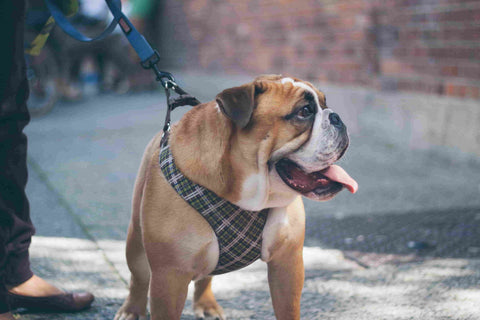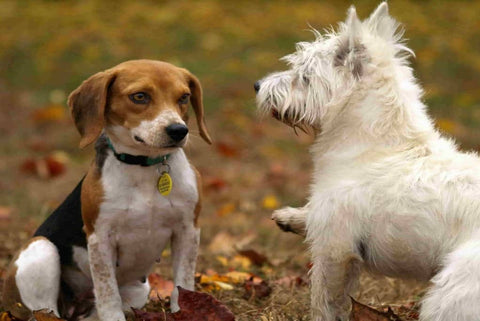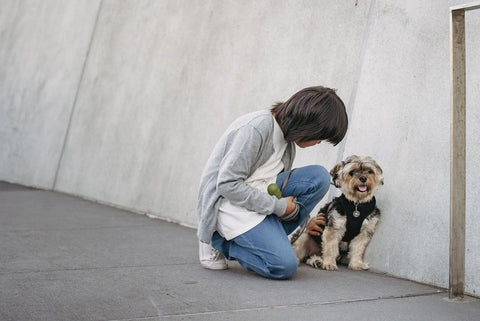Where Should a Harness Sit on a Dog?
If you’re wondering whether or not you should consider a harness for your dog, the answer is yes! Harnesses offer safety and comfort, making for the best possible walking experience. Fit matters with the harness you choose, though.
At Pet&Cuddle, we’re dedicated to providing not just the best products for dogs and their families but also making sure that you get a custom experience every time. Below we cover everything you should know to pick a harness that fits your dog perfectly.
Getting the Proper Fit
Fit matters when it comes to harnesses. One that doesn’t fit well can cause your dog discomfort and create the opportunity to escape. If a dog’s harness is too small, it can restrict his movements. That alters his stride and may lead to unnecessary stress on the body.
Step 1 - Measure Your Dog’s Neck Girth
To start measuring your dog for a harness, take a look at his neck first. Neck girth begins at the base of the neck, and you can wrap a tape measure around this thickest point.
Ideally, to get a measure of the neck, you can also put your tape measure at the spot between his shoulder blades and measure to the top of the chest. Aim to measure around the point where a collar would naturally fit.
Step 2 - Measure Chest Girth
The girth of your dog’s chest should be measured at the largest point of its underside. This is typically right behind the armpits, and there will be a chest strap here on most harnesses.
To get this measurement, start at the bottom of your dog’s rib cage. Then, bring your measuring tape up and over its back. Wrap it to your starting point.
Step 3 - Measure Body Length
Begin with your tape measure located just behind your dog’s front leg, and then bring it to the point right behind his rear leg to get a body length measurement.
Step 4 - Weight
Your dog’s weight can actually help you figure out which harness is best as well as the above measurements. Choose a harness with the right weight limit to prevent having your dog break it if they were to suddenly lunge or pull.
Once you have the above measurements, Pet&Cuddle has detailed size charts to refer to and follow in choosing the right dog harness.
Note #1: When getting your dog’s measurements and weight to fit a dog harness, if you find that you’re close to a cutoff, then you should size up. You can adjust accordingly when the harness is a bit bigger, but if it’s too tight, there’s not much you can do.
Note #2: Once you have a new harness, there’s an easy way to fit test it. Start by putting two fingers under any strap. You should be able to slide them under any point of the harness. If you can’t do so easily or comfortably, then the harness is too tight.
Besides, you can also try to pull the harness over your dog’s head, which you shouldn’t be able to do. However, if you can, the harness is too big.
Choosing the Best Type of a Dog Harness
First of all, the benefits of a dog harness compared to a collar are comfort and safety. However, if you don’t choose the right size and opt for a high-quality harness, then you’re not getting these benefits. You’re also potentially putting your dog at risk with a poor-fitting harness. Beyond size considerations, there are also a few style choices available, which we provide you with more information about below, so you can make the right decision for your needs.
Back Clip Dog Harness
A back clip harness:
- Is best for a well-trained dog
- Is a good option if your dog doesn’t have a habit of pulling or walking
- Provides safety and comfort
With a back clip dog harness, since the clip is located at your dog’s back and on the top, it doesn’t create the tension or pulling feeling of a front-clip harness. You do tend to have less control as a result, but for a well-trained dog without a tendency to pull, it’s a great option.
Front Clip Dog Harness (No-Pull Harness)
Features of a front clip harness include:
- Delivers additional control
- Front leash attachment causes tension if your dog tries to pull
- Works well for a dog still in training
A front clip dog harness is good for dogs that are still learning proper walking techniques or who have issues with pulling or lunging. It offers you more control, and it puts some tension on your dog’s shoulder blades if they attempt to pull, which helps them learn not to do it.
While a front-clip dog harness does counteract your dog’s tendency to pull, it doesn’t cause any type of coughing, choking, or discomfort.
Step-in Dog Harness
A step-in dog harness:
- Creates a rectangle around your dog’s legs, while a standard dog harness forms rectangles
- Is easy to put on in most cases
- Can be safer for a dog’s neck
With a step-in dog harness, your dog simply puts his legs between the two loops. You don’t have to pull anything over his head or fidget with straps. Then, when your dog is positioned, there’s just one buckle attaching behind his front legs.
Along with a simpler design, a step-in dog harness distributes the leash pressure across your dog’s shoulders and chest. With a collar, on the other hand, the pressure is concentrated on a dog’s trachea, possibly causing choking.
Some dogs don’t prefer harnesses that are put on over their head either, which is another reason to consider a step-in option.
Dual Clip Dog Harness
With a dual-clip dog harness, features include:
- Versatility to use either a front or back clip
- You can change which clip you use depending on the situation—for example, if you’re in a crowded place, you might want the control of the front clip, but in a more open area you can switch to the back clip
- Dual clip harnesses can be used for training
With a dual-clip harness, you get the best of both worlds. When you need control or you’re working on the walking technique, you can use the front clip. Then, when you’re ready and your dog is as well, you can move to the back clip. At Pet&Cuddle, we highly recommend that you consider a dual-clip harness.
What Makes Harnesses Better Than Collars?
There are a few key ways that harnesses are better than collars.
- Control: When you’re walking your dog, you want to feel in control of your dog’s safety and your own peace of mind. With the additional attachment and pressure points across your dog’s body, you have significantly more control when you’re using a harness as compared to a collar, without the risk of discomfort.
- Training: Learning the walking technique is an important skill for your dog. Using a harness is an effective training tool, especially when you use the front clip. The front clip gently helps your dog learn not to pull when they’re walking. A well-trained dog is going to mean more enjoyable walks for both of you.
- Safety: Harnesses reduce pressure on the neck, and they also lessen the potential for your dog to slip out and escape.
- Functionality: You can walk your dog without any threat to his health or safety with a harness. Plus, there’s versatility with a harness not available with a collar. You can change the clip for example as needed.
What Features Should You Consider in a Dog Harness?
Along with making sure you get the right fit, look for these key features in a dog harness:
- Safety: A safely designed harness won’t choke your dog and won’t cause health issues. At Pet&Cuddle, safety is the biggest priority in each of our harness designs. We have rigorous safety standards for each of our products.
- Easy to use: If your dog’s harness is easy for you to use, you’ll be more inclined to go on frequent walks, which is important for your dog’s mental and physical health. An easy-to-use harness should be simple to put on and take off. The design should be inherently user-friendly.
- Adjustable Belts: Even when you follow our above guidelines to ensure the proper fit, a little more adjustment may be necessary so it’s perfect. When a dog harness has an adjustable belt, you can customize the fit.
- Weight: Part of a harness being user-friendly for you means that it’s transportable. It should be lightweight enough that you can bring it with you anywhere you go.
- Clip Location: The location of a D-ring clip can be either at the front or back of the harness, or you can have a harness with both clips. When you have both, you can use your harness for training your dog and also after he’s learned proper walking techniques.
- Reflective Straps: If you like an early morning or evening walk, reflective straps are an important safety feature.
- Material: Think about how a harness will feel on your dog’s skin. You don’t want a rough or harsh material that will lead to unnecessary rubbing or injury. Choose a soft, comfortable material. The clip material should be metal so that it will be durable and long-lasting.
Is It Okay to Use a Retractable Leash with a Harness?
The advantages of a retractable leash are extensive. When you walk your dog with a retractable leash, they have more freedom that helps them develop self-confidence. They can also be used for training as your dog learns how to heel on walks. You have the ability to reel a leash in if needed but the flexibility to offer freedom as the situation calls for it.
So can you use a retractable leash with a harness? This is safe, but with some reminders.
When using both a retractable leash and a harness if your dog is still training not to pull you may be using the front clip. If you are using the front clip along with a retractable leash, don’t let the leash generate tension on the clip. That can confuse your dog and he’ll think he’s pulling when he’s not.
Instead, when you’re using a retractable leash and harness together, give a little slack in the leash, or attach to the back clip instead of the front.
The Importance of Getting a Proper Fit
Getting a properly fitted harness is going to help you maximize the many benefits. If you’ve made the choice that a harness is the best option for you and your dog, we encourage you to take the measurements and then browse our Pet&Cuddle selection.
We, the Pet&Cuddle dog lovers, are constantly creating new dog harness collections, which are safe and effective for training, leading, or adapting purposes. Discover the latest dog harness collection we created exactly for your dog here.
Questions About Dog Harnesses
As the leading experts in dog harnesses, we compiled answers to some of the questions we get most frequently.
Are Harnesses Good for Dogs?
Harnesses aren’t just good for dogs—they’re better than collars. They give you a sense of control while delivering comfort and safety for your dog. They don’t create the pulling or choking sensation of a collar, yet they’re effective training tools.
What Age Can You Put a Harness on a Puppy?
Since a dog harness is a good option to train a dog on walking techniques and related commands, starting him early with a harness is ideal. Veterinarians do recommend that you wait until your puppy is at least eight months old before you use a harness, but beyond that point, you can use them without fear of tangling or injury.
How to Pick the Right Size Harness?
The right size harness is one of the main determining factors of experience, comfort, and safety. You need to measure your dog because it’s common to over-or under-estimate their size. With measurements, you’ll be able to use the Pet&Cuddle size chart without second-guessing whether or not you’re getting the right size.
How Tight Should a Dog Harness Be?
A dog harness should fit in a way that allows you to slip two fingers under any strap at any point on your dog’s body. You can also check the fit by trying to pull the harness over your dog’s head. You shouldn’t be able to if the fit is secure.
Can a Dog Wear a Collar and a Harness?
There’s no need for a dog to wear a collar and a harness. The features between the two overlap, but a harness is superior as far as both safety and comfort. A harness gives you the ability to do different activities in a variety of settings and works well for both training a dog and for a dog that knows walking techniques.
Get the Best Harness from Pet&Cuddle
Choosing a safe, comfortable, and well-fitting harness is a decision that will improve your life and your dog’s quality of life. We at Pet&Cuddle have processed all the knowledge and practical experience to create the perfect harness with a unique design. Comfortable and safe, it now can easily be used for many purposes like training, walking, or adapting to a leash. Discover the latest products for dogs available on our website!




